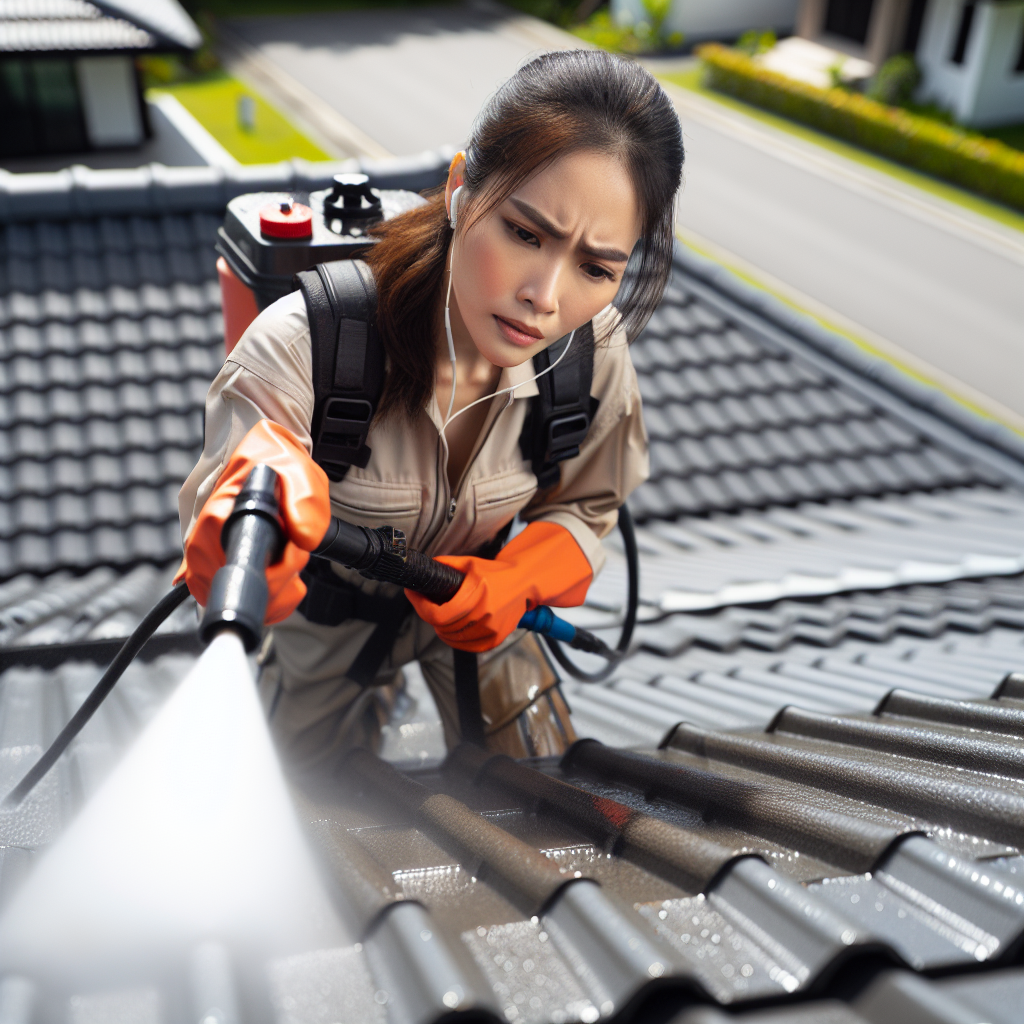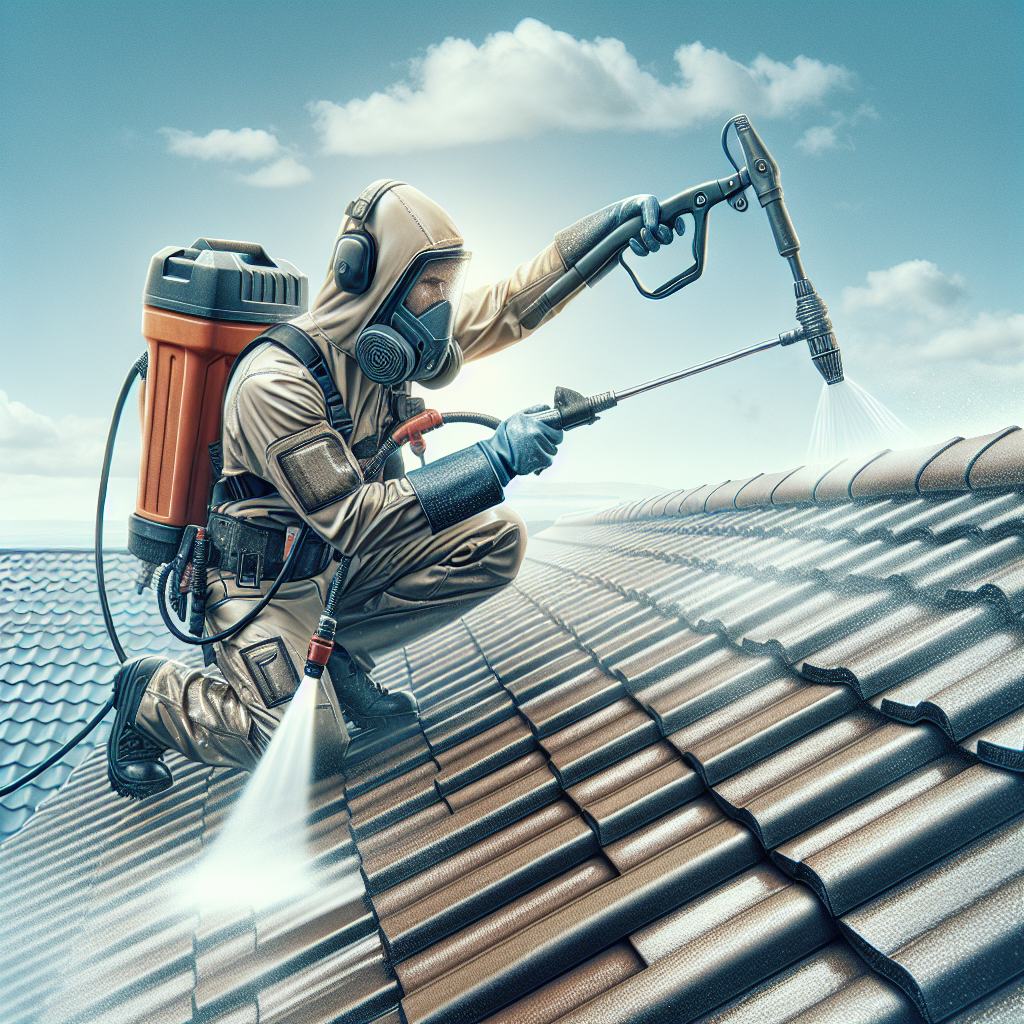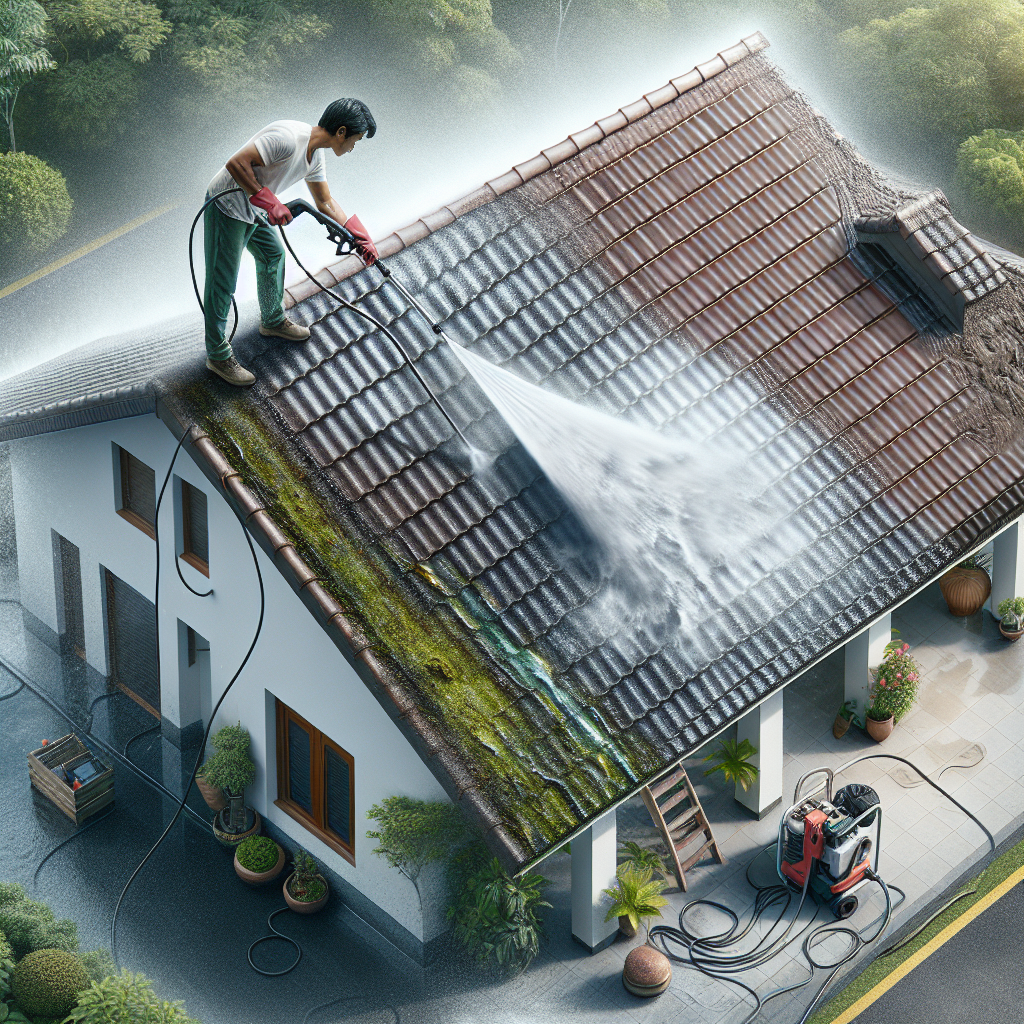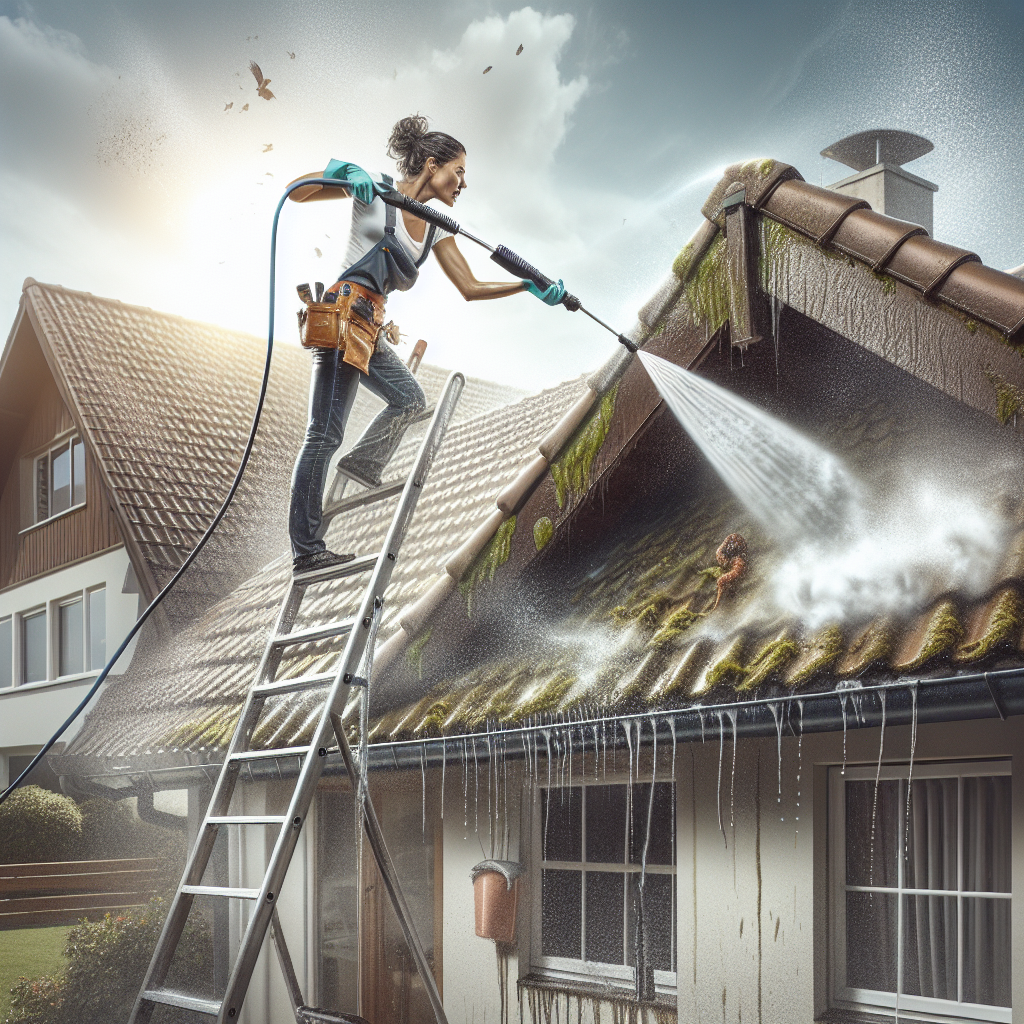Pressure Cleaning a Roof: Essential Tips and Tricks
Pressure cleaning a roof is a crucial task to maintain the *longevity* and *aesthetic appeal* of your home. Over time, roofs accumulate dirt, mold, algae, and other debris, which can lead to damage and unsightly appearances. By employing professional pressure cleaning techniques, homeowners can ensure their roofs stay in optimal condition for years to come.
When considering pressure cleaning a roof, it’s essential to understand the different types of roofing materials and how they respond to high-pressure water. Common materials include asphalt shingles, tiles, and metal, each requiring specific pressure levels and cleaning methods to avoid damage. For instance, asphalt shingles are more susceptible to high pressure, which can strip away the protective granules, whereas tiles can handle more intense cleaning but require careful handling to prevent cracking.
*Safety* is another critical factor when pressure cleaning a roof. The process involves working at heights and handling powerful equipment, which can be dangerous without proper precautions. Using safety gear, such as harnesses and non-slip shoes, and understanding the correct operation of pressure cleaning equipment can significantly reduce the risk of accidents.
Moreover, the benefits of pressure cleaning a roof extend beyond mere aesthetics. Regular maintenance can prolong the lifespan of the roof, prevent costly repairs, and even improve energy efficiency by removing heat-absorbing dark stains.
For professional and reliable pressure cleaning services, contact us today or call/text 561-718-9851! Our experts are here to help you maintain a pristine and durable roof.
Benefits of Pressure Cleaning Your Roof
There are numerous benefits associated with *pressure cleaning your roof*. One of the most significant advantages is the *enhanced curb appeal*. A clean roof dramatically improves the overall appearance of your home, making it look well-maintained and inviting. This is particularly beneficial if you are considering selling your property, as first impressions are crucial for potential buyers.
Another key benefit is the *prevention of roof damage*. Over time, debris such as leaves, dirt, and organic growth like algae and moss can accumulate on your roof. These elements can cause moisture to get trapped, leading to rot and deterioration of roofing materials. Regular pressure cleaning helps to remove these harmful deposits, thus extending the lifespan of your roof.
Moreover, pressure cleaning can *improve the efficiency of your roof*. Algae and dark stains can absorb heat, increasing the temperature inside your home and forcing your air conditioning system to work harder. By removing these stains, your roof can reflect sunlight more effectively, leading to better energy efficiency and potentially lower utility bills.
Additionally, maintaining a clean roof through pressure cleaning can help in *preventing infestations*. Pests such as insects, birds, and rodents are often attracted to debris and organic matter on roofs. By keeping your roof clean, you reduce the likelihood of these pests making a home under your shingles or tiles.
Lastly, pressure cleaning is a proactive measure that can help you *identify potential issues early*. During the cleaning process, you or the professionals can spot areas that need repair or extra attention, allowing you to address minor problems before they escalate into costly repairs.
Essential Tools for Roof Pressure Cleaning
To successfully undertake *pressure cleaning a roof*, having the right tools is crucial. Investing in the proper equipment not only ensures a thorough cleaning but also enhances safety and efficiency. Here are some essential tools you’ll need:
- Pressure Washer: The cornerstone of roof pressure cleaning, a pressure washer helps blast away dirt, algae, and moss. Opt for a model with adjustable pressure settings to avoid damaging the roofing materials.
- Extension Wand: This tool allows you to reach high or difficult areas without needing to climb onto the roof, minimizing risk while providing effective cleaning.
- Rotating Nozzles: These nozzles provide a more thorough clean by rotating the water jet, effectively removing stubborn grime and stains. Select nozzles compatible with your pressure washer for optimal results.
- Safety Gear: Safety is paramount when working at heights. Equip yourself with non-slip shoes, safety goggles, gloves, and a harness to prevent falls. A stable ladder with a stabilizer is also essential to ensure safe access to the roof.
- Chemical Detergents: Specialized roof cleaning detergents can help break down organic material such as moss and algae. Ensure the detergents you choose are environmentally friendly and safe for your roofing material.
- Gutter Cleaning Tools: A clean roof often means clean gutters. Use gutter scoops or specialized attachments to your pressure washer to clear out debris, preventing water damage and ensuring proper drainage.
- Soft-Bristle Brush: For delicate areas or stubborn spots, a soft-bristle brush can be used in conjunction with cleaning solutions to scrub away residue without damaging the roof surface.
Equipping yourself with these essential tools not only makes the process of pressure cleaning a roof more manageable but also ensures that the job is done effectively and safely. Always remember to follow the manufacturer’s guidelines for each tool to maximize their lifespan and efficiency.
Step-by-Step Guide to Pressure Cleaning
Embarking on the task of *pressure cleaning a roof* can seem daunting, but following a systematic approach can simplify the process. Here’s a step-by-step guide to help you achieve a clean and well-maintained roof:
- Preparation: Begin by inspecting your roof for any damage or weak spots. Clear away loose debris such as leaves and branches. Ensure that nearby plants and outdoor furniture are protected by covering them with plastic sheeting or tarps.
- Safety First: Equip yourself with appropriate safety gear including non-slip shoes, gloves, safety goggles, and a harness. Secure a stable ladder with a stabilizer to safely access the roof.
- Set Up Your Equipment: Assemble your pressure washer and attach the necessary nozzles and extension wands. Adjust the pressure settings according to the type of roofing material to avoid damage.
- Apply Cleaning Solution: Use a specialized roof cleaning detergent. Apply the solution using a low-pressure setting or a garden sprayer. Let the detergent sit for the recommended time to break down moss, algae, and grime.
- Rinse the Roof: Using the pressure washer, start rinsing from the top of the roof and work your way downward. This prevents water from seeping underneath the shingles. Use a sweeping motion to ensure even coverage and thorough cleaning.
- Target Stubborn Areas: For areas with persistent stains or heavy buildup, use a rotating nozzle or a soft-bristle brush to scrub away the grime gently.
- Clean the Gutters: Don’t forget to clean the gutters to prevent clogs and ensure proper water drainage. Use gutter cleaning attachments for your pressure washer or manually scoop out debris.
- Final Inspection: After cleaning, conduct a final inspection of your roof. Check for any areas that may need additional attention or repair. Remove protective coverings from plants and outdoor furniture.
By following these steps, you can ensure a comprehensive and effective roof cleaning. Regular maintenance will extend the life of your roof and keep your home looking its best.
Safety Tips for Roof Pressure Cleaning
Ensuring safety while *pressure cleaning a roof* is paramount. The combination of high-pressure water, heights, and slippery surfaces can pose significant risks. Here are some essential safety tips to help you stay protected:
- Wear Appropriate Safety Gear: Equip yourself with non-slip shoes, gloves, safety goggles, and a hard hat. A safety harness is highly recommended, especially for steep or high roofs.
- Inspect Your Equipment: Before starting, thoroughly check your pressure washer for any leaks, damages, or loose parts. Ensure all connections are secure and the equipment is functioning properly.
- Clear the Work Area: Remove any obstacles around your workspace to prevent tripping or falling. Secure ladders with stabilizers and place them on flat, stable ground.
- Mind the Power Lines: Be aware of any overhead power lines near your roof. Maintain a safe distance to avoid accidental contact, which can cause severe injuries or fatalities.
- Use the Correct Nozzle: Select a nozzle that provides the right pressure for your roof type. Using a nozzle with too much pressure can damage roofing materials, while too little pressure may be ineffective.
- Maintain a Firm Footing: Always keep a firm footing and use a wide stance while working. Avoid leaning or overreaching, as this can cause loss of balance. Work in sections to maintain control.
- Be Cautious with Water Pressure: Start with a low-pressure setting and gradually increase if necessary. High-pressure water can cause serious injuries if it comes into contact with skin.
- Work with a Partner: Having someone nearby can be invaluable. They can assist with equipment, provide an extra set of eyes for safety, and help in case of emergency.
- Avoid Wet or Windy Conditions: Perform roof cleaning on a dry, calm day. Wet surfaces are more slippery, and strong winds can make it difficult to control the pressure washer.
- Take Breaks and Stay Hydrated: Roof cleaning can be physically demanding. Take regular breaks to rest and hydrate, especially on hot days, to avoid fatigue and heat-related issues.
By adhering to these safety tips, you can minimize risks and ensure a safe and successful roof cleaning experience. Safety should always be your top priority when undertaking such tasks.
Maintaining Your Roof Post-Cleaning
Once you’ve successfully completed *pressure cleaning your roof*, the next crucial step is to maintain it to ensure long-lasting results. Proper maintenance not only prolongs the cleanliness of your roof but also helps in preventing damage and costly repairs. Here are some effective maintenance tips to follow:
- Regular Inspections: Conduct routine inspections of your roof to identify any signs of wear, damage, or debris accumulation. Early detection of issues like cracked shingles or loose tiles can prevent more severe problems down the line.
- Gutter Cleaning: Ensure that your gutters are free from leaves, twigs, and other debris. Clogged gutters can cause water to overflow, leading to potential water damage to your roof and home exterior.
- Trim Overhanging Branches: Trees with overhanging branches can deposit leaves, sticks, and other debris onto your roof, promoting mold growth and moisture retention. Regularly trim these branches to keep your roof clear.
- Check for Algae and Moss: Keep an eye out for any regrowth of algae, moss, or lichen. If spotted, treat the affected areas promptly with a roof-safe cleaner to prevent them from spreading and causing damage.
- Maintain Proper Ventilation: Ensure your attic and roof have adequate ventilation. Proper airflow helps in reducing moisture buildup, which can lead to mold growth and wood rot.
- Repair Minor Damages Promptly: Address any minor damages, such as small leaks or missing shingles, as soon as they are noticed. Quick repairs can prevent them from escalating into more significant, costly issues.
- Professional Maintenance: Schedule regular maintenance with a professional roof cleaning service. They can provide a thorough inspection and address any issues that may not be visible to the untrained eye.
By following these maintenance tips, you can keep your roof in top condition and extend its lifespan significantly. Proper upkeep after pressure cleaning ensures that your efforts are not in vain and that your roof remains a protective barrier for your home.
If you need expert assistance in maintaining your roof post-cleaning, don’t hesitate to call or text 561-718-9851 for professional services and advice.




Recent Comments